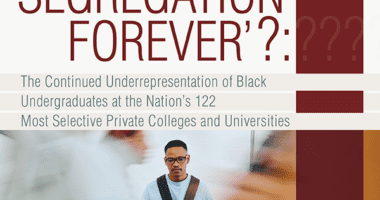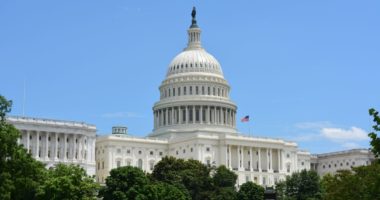Promise Abandoned: How Policy Choices and Institutional Practices Restrict College Opportunities
(Washington, D.C.) — A new report released today from the Education Trust sharply criticizes trends in federal, state, and college practices that discourage low-income and minority students from enrolling and graduating from college. In fact, despite the perception of progress, gaps in college-going and college completion for poor and minority students are actually wider than they were thirty years ago.
The report Promise Abandoned: How Policy Choices and Institutional Practices Restrict College Opportunities documents the retreat from our national commitment to make college a reality for low-income students who work hard in school. It calls on policymakers to restore the practice of awarding financial aid first to the students who cant attend college without it, and it calls on universities to take responsibility for admitting and graduating their fair share of low-income and minority students.
The report includes a brand new analysis commissioned by the Education Trust, exposing the under-the-radar decisions within higher education that have shifted scarce financial aid money away from low-income students to help institutions recruit students from more affluent families. Over the last ten years, institutional financial aid decisions have disadvantaged low-income students even more than the shifts in federal and state programs that have garnered more attention.
”Colleges and universities are not just victims of bad policy choices, they too are making bad choices, and in the process they are shutting the doors of opportunity for low-income students,” said Kati Haycock, Director of the Education Trust and author of the report.
The report also focuses attention on graduation rates for the students who do make it to college, highlighting the colleges and universities with the best and worst graduation rates for African-American and Latino students, and calls for greater attention to improving undergraduate student success.
”The numbers are heart-breaking,” said Haycock. “At just the moment when governors and K-12 leaders are working so hard to reshape high schools so all of their graduates will be ready for college, our higher education system seems to be heading in the opposite direction.”
The lack of progress can be attributed in part to federal, state, and college policies that increasingly award financial aid to middle- and upper-income students, at the expense of poor young people. Among those policies:
- Enrollment practices that purchase high school talent with financial aid to enhance prestige in ratings guides and consequently deny much-needed financial aid to low-income students who need it most;
- Insufficient federal funding for Pell Grants, which has diminished the value of these grants significantly in 1975, the average Pell Grant covered nearly 84 percent of the cost of college, today the average Pell Grant only covers 36 percent;
- Inadequate increases in state expenditures on need-based financial aid – whereas states have increased funding for need-based aid by 70 percent over the last thirty years, they have increased funding for non-need-based aid by 300 percent.
The results are devastating: this country’s four-year colleges, long the engine of social and economic mobility, look less and less like America. For example, high-achieving students from the lowest-income families are only attending college at the same rate as the lowest-achieving students from wealthy families.
”When our nations four-year colleges look more like bastions of privilege than engines of opportunity, we pay a serious national price,” said Haycock. “Today, our country not only has less economic mobility than we did 20 years ago, but we have less than in most other developed countries.”
Instead of devoting money and support to make college a reality for students with the least resources, federal and state governments and institutions themselves are systematically denying these students the opportunities they deserve.
“These policies undermine the notion of the American dream no matter how hard these students work, and no matter how high they achieve in high school, they still may not be able to afford college,” said Ross Wiener, Policy Director at the Trust. “It is simply unconscionable that leaders in both government and higher education are sending precious aid money to students from wealthy families while young people from poor families are shut out.”
But the problems dont stop at enrollment. Too few low-income and minority students graduate from college once they’ve entered. Using College Results Online, the Education Trusts webtool on college graduation rates, data for most colleges show enormous disparities in graduation rates for minority students. Nationally, only 40 percent of full-time, first-time African American freshmen and 47 percent of Latino freshmen graduate from the college where they initially enrolled within six years. For White students, the six-year graduation rate is 59 percent. Longitudinal studies show that another 7-8 percent of African-American and Latino students graduate from different institutions, but the racial gaps remain large.
The Ed Trust report calls upon colleges to work harder to make sure that low-income and minority students actually graduate. These students are more likely to enter college less-prepared than their white and more affluent counterparts - for which public high schools are partly to blame. However, once universities admit these students, they have a responsibility to help them obtain their degree.
”Our analysis documents that a lot of colleges are already stepping up to these responsibilities,” said Wiener. ”And when they really focus on student success, they get much better results. Some institutions have only very small graduation rate gaps – or none at all – and they run the gamut from big, elite universities to smaller, regional colleges. But the truth is that too many schools accept dismal graduation rates as inevitable, and policymakers havent acted aggressively to address the problems.”
The report provides examples and recommendations on what can be done to increase minority and low-income student enrollment, and also ensure that these students graduate. Among them:
- The federal government should restore the purchasing power of the Pell Grant, and limit increases in other aid programs until Pell Grants cover at least 80 percent of the costs of attending a public university;
- States should adopt accountability systems to ensure that colleges and universities serve a fair proportion of low-income and minority students;
- Colleges and universities should revise financial aid packages for lower-income students, eliminating loan obligations during the first two years and reducing obligations in later years.
The report also suggests that colleges and universities make a concerted effort to cut graduation rate gaps in half over the next five years.
“If colleges and universities really committed themselves to this step alone, they could produce an additional 15,000 African-American and Latino graduates per year and over 150,000 more over a decade,” said Haycock. ”This would be an important first step toward repairing the American Dream.”









